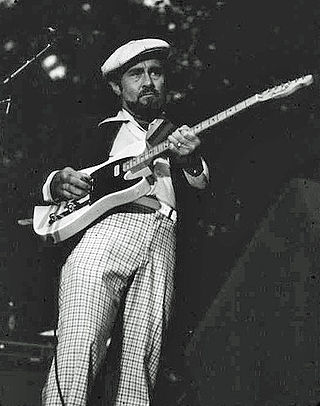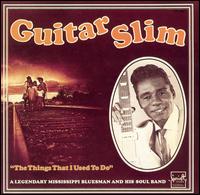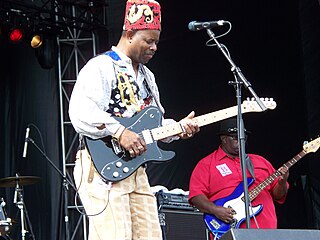
James Marshall "Jimi" Hendrix was an American guitarist, songwriter and singer. Although his mainstream career spanned only four years, he is widely regarded as the greatest and one of the most influential electric guitarists in the history of popular music, and one of the most celebrated musicians of the 20th century. The Rock and Roll Hall of Fame describes him as "arguably the greatest instrumentalist in the history of rock music."

Slide guitar is a technique for playing the guitar that is often used in blues music. It involves playing a guitar while holding a hard object against the strings, creating the opportunity for glissando effects and deep vibratos that reflect characteristics of the human singing voice. It typically involves playing the guitar in the traditional position with the use of a slide fitted on one of the guitarist's fingers. The slide may be a metal or glass tube, such as the neck of a bottle, giving rise to the term bottleneck guitar to describe this type of playing. The strings are typically plucked while the slide is moved over the strings to change the pitch. The guitar may also be placed on the player's lap and played with a hand-held bar.
Jimmy James and the Blue Flames was a short-lived American rock group that was fronted by Jimi Hendrix, who was then going by the name "Jimmy James". The band was Hendrix's first extended foray into the 1966 Greenwich Village music scene and included future Spirit guitarist Randy California. At various New York clubs, they played a mix of rock, blues, and rhythm and blues songs as well as early versions of songs that became part of the Jimi Hendrix Experience repertoire. It was at such a performance that the Animals' bassist Chas Chandler first heard their rendition of "Hey Joe" and decided to invite Hendrix to England and become his producer.
Electric blues is blues music distinguished by the use of electric amplification for musical instruments. The guitar was the first instrument to be popularly amplified and used by early pioneers T-Bone Walker in the late 1930s and John Lee Hooker and Muddy Waters in the 1940s. Their styles developed into West Coast blues, Detroit blues, and post-World War II Chicago blues, which differed from earlier, predominantly acoustic-style blues. By the early 1950s, Little Walter was a featured soloist on blues harmonica using a small hand-held microphone fed into a guitar amplifier. Although it took a little longer, the electric bass guitar gradually replaced the stand-up bass by the early 1960s. Electric organs and especially keyboards later became widely used in electric blues.

Electric Ladyland is the third and final studio album by the Jimi Hendrix Experience, released in October 1968. A double album, it was the only record from the Experience with production solely credited to Hendrix. The band's most commercially successful release and its only number one album, it was released by Reprise Records in the United States on October 16, 1968, and by Track Records in the UK nine days later. By mid-November, it had reached number 1 on the Billboard Top LPs chart, spending two weeks there. In the UK it peaked at number 6, where it spent 12 weeks on the British charts.

Frank "Son" Seals was an American electric blues guitarist and singer.
Blues rock is a fusion genre and form of rock music that relies on the chords/scales and instrumental improvisation of blues. It is mostly an electric ensemble-style music with instrumentation similar to electric blues and rock. From its beginnings in the early to mid-1960s, blues rock has gone through several stylistic shifts and along the way it inspired and influenced hard rock, Southern rock, and early heavy metal.

Leroy "Roy" Buchanan was an American guitarist and blues musician. A pioneer of the Telecaster sound, Buchanan worked as a sideman and as a solo artist, with two gold albums early in his career and two later solo albums that made it to the Billboard chart. He never achieved stardom, but is considered a highly influential guitar player. Guitar Player praised him as having one of the "50 Greatest Tones of All Time." He appeared on the PBS music program Austin City Limits in 1977.

Axis: Bold as Love is the second studio album by the Jimi Hendrix Experience. It was first released by Track Records in the United Kingdom on December 1, 1967, only seven months after the release of the group's highly successful debut album, Are You Experienced. In the United States, Reprise Records delayed the release until the following month. The album reached the top ten in the album charts in both countries.

Luther Sylvester Allison was an American blues singer-songwriter and guitarist. He was born in Widener, Arkansas, although some accounts suggest his actual place of birth was Mayflower, Arkansas. Allison was interested in music as a child and during the late 1940s he toured in a family gospel group called The Southern Travellers. He moved with his family to Chicago in 1951 and attended Farragut High School where he was classmates with Muddy Waters' son. He taught himself guitar and began listening to blues extensively. Three years later he dropped out of school and began hanging around outside blues nightclubs with the hopes of being invited to perform. Allison played with the bands of Howlin' Wolf and Freddie King, taking over King's band when King toured nationally. He worked with Jimmy Dawkins, Magic Sam and Otis Rush, and also backed James Cotton. Chicago Reader has called him "the Jimi Hendrix of blues guitar".
"Voodoo Chile" is a song written by Jimi Hendrix and recorded in 1968 for the third Jimi Hendrix Experience album Electric Ladyland. It is based on the Muddy Waters blues song "Rollin' Stone", but with original lyrics and music. At 15 minutes, it is Hendrix's longest studio recording and features additional musicians in what has been described as a studio jam.

"Killing Floor" is a 1964 song by American blues singer-songwriter and guitarist Howlin' Wolf. Called "one of the defining classics of Chicago electric blues", "Killing Floor" became a blues standard with recordings by various artists. It has been acknowledged by the Blues Foundation Hall of Fame, which noted its popularity among rock as well as blues musicians. English rock group Led Zeppelin adapted the song for their "The Lemon Song", for which Howlin' Wolf is named as a co-author.

"The Things That I Used to Do" is a blues standard written by Guitar Slim. He recorded it in New Orleans, where the young Ray Charles arranged and produced the session. Specialty Records released the song as a single in 1953 and it became a bestseller the following year. Specialty founder Art Rupe believed that the appeal would be limited to the Southern U.S. rural audience. However, urban rhythm and blues radio stations in the North began airing the song and built it into a national hit. As a result, Guitar Slim became in great demand as a performer and played at venues such as the Apollo Theater in New York City.

David William Kearney, known as Guitar Shorty, was an American blues guitarist, singer, and songwriter. He was known for his explosive guitar style and wild stage antics. Credited with influencing both Jimi Hendrix and Buddy Guy, Guitar Shorty recorded and toured from the 1950s until the 2020s. In 2017, Billboard magazine said, "his galvanizing guitar work defines modern, top-of-the-line blues-rock. His vocals remain as forceful as ever. Righteous shuffles...blistering, sinuous guitar solos."

Lil' Ed Williams is an American blues slide guitarist, singer and songwriter. With his backing band, the Blues Imperials, he has built up a loyal following.

"You Don't Love Me" is a rhythm and blues-influenced blues song recorded by American musician Willie Cobbs in 1960. Adapted from Bo Diddley's 1955 song "She's Fine She's Mine", it is Cobbs' best-known song and features a guitar figure and melody that has appealed to musicians in several genres.
Lacy Gibson was an American Chicago blues guitarist, singer and songwriter. He notably recorded the songs "My Love Is Real" and "Switchy Titchy" and in a long and varied career worked with Buddy Guy and Son Seals.

Selwyn Birchwood is an American blues guitarist, vocalist and songwriter from Tampa, Florida. He was the winner of the Blues Foundation’s 2013 International Blues Challenge, as well the winner of the Albert King Guitarist of the Year award, presented at the same event. To win, he bested 125 other bands from around the world. Birchwood plays electric guitar and electric lap steel guitar. His live performances feature his original songs. Living Blues magazine said, "Selwyn Birchwood is making waves, surprising people and defying expectations. Be on the lookout. He revels in the unexpected." The Tampa Tribune said Birchwood plays with "power and precision reminiscent of blues guitar hero Buddy Guy. He is a gritty vocalist [who is] commanding with his axe." Rolling Stone said "Birchwood is a young, powerhouse guitarist and soulful vocalist. Don't Call No Ambulance is a remarkable debut by a major player." The Washington Post said, "Selwyn Birchwood is an indelibly modern and original next-generation bluesman; his tough vocals, guitar and lap steel touch on classic Chicago blues, Southern soul and boogie."

Toronzo Cannon is an American electric blues guitarist, vocalist and songwriter. He grew up on the South Side of Chicago near the Robert Taylor Homes and Theresa's Lounge where he heard blues artists including Buddy Guy and Junior Wells.














